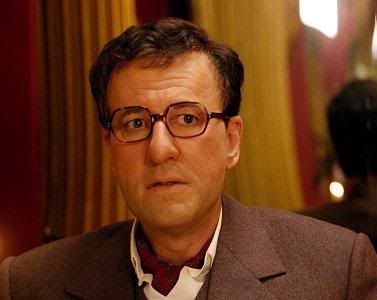My PulpFilm reviews 2005-2006:

Serenity
dir. Joss Whedon
As you may well be aware, Joss Whedon’s Serenity is a spinoff of his prematurely cancelled cult TV show Firefly, resurrected after much protesting from loyal fans. As such, Pulp approached the film with trepidation—although fans of Whedon’s far more successful Buffy the Vampire Slayer, Pulp knew next to nothing of the back-story to this sci-fi adventure. However, first-time viewers need not worry, as Serenity works very well as a stand-alone film, full of Whedon’s characteristic piquant humor, a marvelous ensemble (Dodgeball fans should look out for Alan Tudyk, aka Steve the Pirate, as the neurotic pilot) and some terrific action. Unlike some of Hollywood’s more straightforward attempts at the good old-fashioned action-adventure film this summer, Serenity has a spontaneous, cheep-but-cheerful charm that compliments the central group of characters, a bunch of loveable space bandits. The film balances moments of real darkness with frequent dashes of sparkling verbal wit, keeping the pace quick and the audience constantly entertained. It’s not perfect: there are a few spotty moments where the plot seems rushed along, a couple of characters pop up out of nowhere and there are probably numerous references that only fans of the TV show will understand. But Serenity gets by on its vim and vigour, and it’s hard not to be won over by the breezy charm of Nathan Fillion as the roustabout Captain Mal Reynolds. If you’re no sci-fi fan, this isn’t the movie for you, but if you have even a mild interest, give it a shot—you’ll find yourself pleasantly surprised.
****

Hidden
dir. Michael Haneke
From the supremely twisted Michael Haneke (Funny Games, The Piano Teacher) comes Hidden, an intriguing psychological thriller with a dazzling concept and powerful, politically charged subtext. The setup is masterfully simple: a relatively well-off French family in Paris anonymously receive surveillance tapes of themselves, a static hidden camera shooting outside of their house for hours on end, with no explanations or demands. Even though there is technically no threat, the very idea that they are being watched is so troubling to the husband (Auteuil) and wife (Binoche) that seeds of distrust and resentment are quickly sown. New tapes of other locations soon emerge, secrets are revealed and the tension continues to mount unbearably. It’s brilliantly executed by Haneke, who makes the most straightforward scenes nerve-wracking and squirrels away details in every scene that both help solve and complicate the mystery. Hidden’s genius is that is a great edge-of-your-seat thriller that both shocks and asks probing questions of the viewer. Pay close attention (particularly, Pulp would suggest, to the closing shot) and you won’t be able to get Hidden out of your head for days.
****

Stoned
dir. Stephen Woolley
Stephen Woolley’s long-in-the making Stoned chronicles the life and mysterious death of Brian Jones, founding member of the Rolling Stones. As we journey through the murky last months of his life, Jones slips in and out of a lethargic haze, alternately befriending and tormenting his builder Frank Thorogood (an unassuming Paddy Considine). Woolley throws in the requisite vivid flashbacks to days of sex, drugs and hedonism, although the film is curiously skimpy on Jones’ actual musical talents. There’s definite fun to be had here: Leo Gregory is suitably drawly and cool in the lead role, the gruff David Morrissey is great as the Stones’ no-nonsense road manager, and David Walliams of Little Britain pops up in a bizarre cameo as an accountant with the worst glasses ever. There’s something missing, though—Pulp found itself wanting to know more about the interplay between the band, instead of just having Jagger/Richards look-alikes hanging around in the background. Jones’ ambiguous relationship with Thorogood has its moments, but everything else is disappointingly by-the-numbers. All in all, this is just another bland rock biopic that skims over the surface of Jones’ genuinely interesting life and leaves the viewer unsatisfied. If you’re in the market for a genuinely interesting Stones movie, rent Gimmie Shelter—you won’t be disappointed.
**

Confetti
dir. Debbie Isitt
When a film has a cast as good as Confetti’s, it’s setting itself up for a fall. This sweet, sporadically amusing, completely improvised mockumentary contains some of the best of British comedy—Martin Freeman of The Office, Jessica Stevenson of Spaced, Robert Webb of Peep Show, Stephen Mangan of Green Wing and the ubiquitous Jimmy Carr. Pulp went in with high hopes for a cacophony of hilarity, considering the talent involved. But Confetti did not deliver, provoking little more than occasional chuckles from this reviewer. As it is a film about weddings (three themed weddings competing to win a prize), Confetti wears its heart on its sleeve. This is simultaneously its biggest flaw and the only reason to recommend it. Because our feelings are invested in the three couples, it makes it harder to find them figures of amusement (although some of the half-baked, toothless comic situations we find them in hardly help—for example, naturists aren’t funny). But, due in part to the uniformly excellent performances, Confetti is very sweet and on occasion quite touching. Freeman and Stevenson are particularly winsome as the MGM musical couple. It’s enough to keep you alert through the whole thing, which at 90 minutes still seems quite padded out, and the denouement featuring the wedding competition itself is the undisputed highlight of the affair. You won’t be crowning writer/director Debbie Isitt the next Gervais, but Confetti is pleasant enough to keep you happily distracted before the summer blockbuster season.
***







































































